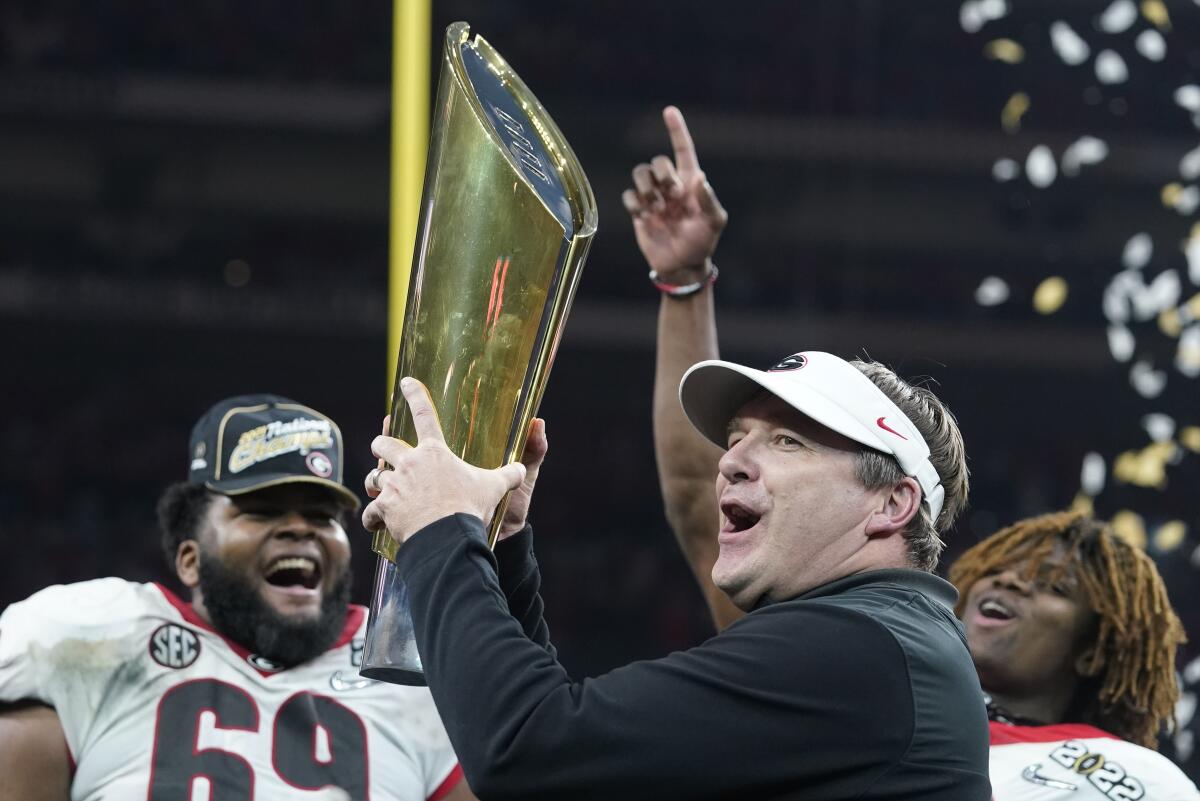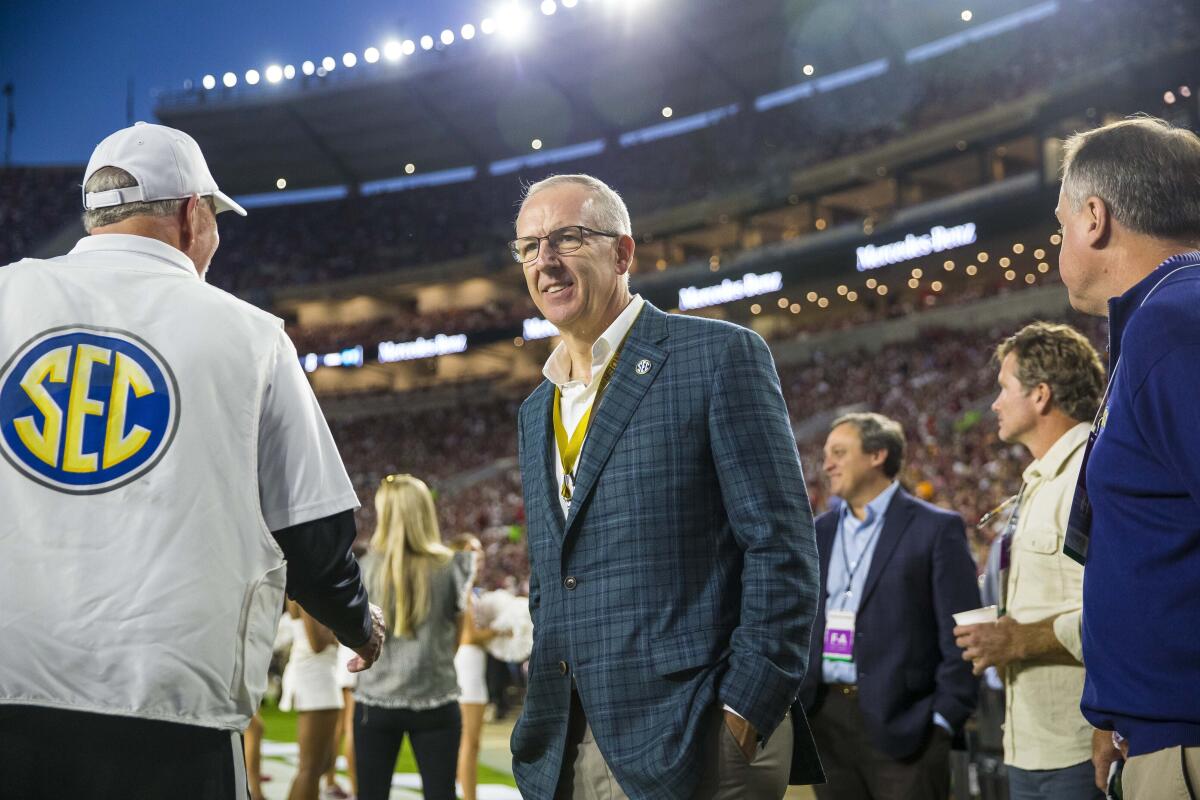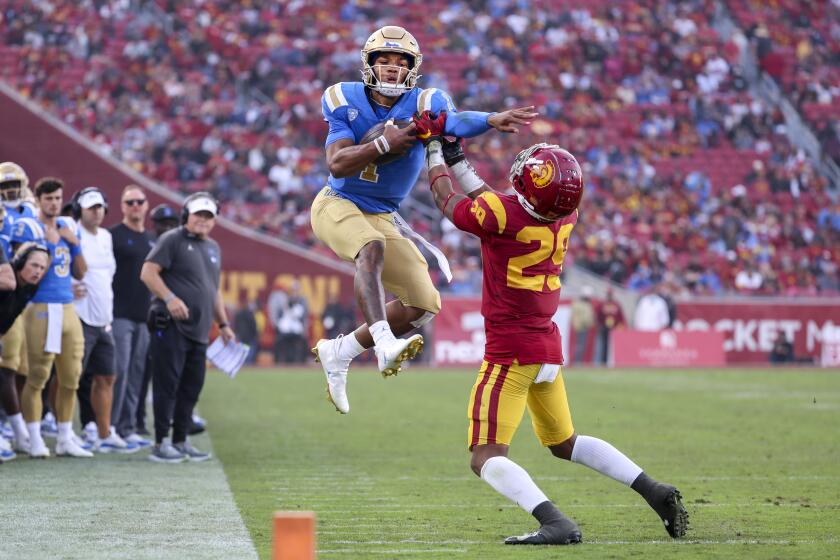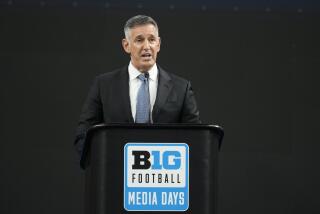Commentary: Pac-12 took heat for delaying playoff expansion. But SEC came out biggest loser

- Share via
For too long, the Pac-12 has served as an almost-willing national punching bag. During the weekend, as passionate college football observers processed the news that the College Football Playoff would not expand before the 2026 season, it was only natural that the sport’s opinion shapers assigned the proverbial clown suit to the West Coast’s Power Five conference.
Once again, based on the narrative being spun from the middle of the country, the league set itself up for ridicule. Pac-12 Commissioner George Kliavkoff had been trumpeting his full support of expansion, his flexibility in hammering out all the minutiae, and yet, when it came to voting, he had said no, along with the Big Ten and Atlantic Coast Conferences. So the Pac-12, which hasn’t been to the four-team playoff since the 2016 season, had somehow refused more access, risking that it might go a full decade without a representative?
Some of the criticism is fair. Some of it isn’t. But, before we get stuck in the same old pattern of picking on the Pac-12, how about we pose a different question: What if the biggest loser in the failure to expand the CFP was the conference with the most to gain — the one that had been pulling the strings harder than any other the last two-plus years to push the number to 12?
Finally, the Southeastern Conference, winner of the last three national championships and 12 of 16 overall, couldn’t bully its way to victory.
Now, a disclaimer: I believe expansion could be great for college football, and of course it would very much benefit the Pac-12 to have more teams invited to the event. The point I’m about to make is that agreeing to it today, given how the process played out the last six months, would have only increased the SEC’s position of dominance over the rest of the Power Five, even the cash-flush Big Ten.
There are many absurd things about college football that we just sort of accept. A glaring one is that it’s an increasingly professional sport that has no national leadership to govern its dealings, putting aside the regional biases that make the game the beautiful spectacle it is.
The College Football Playoff is set to remain a four-team format through the 2025 season after administrators fail to agree on an expansion plan.
SEC Commissioner Greg Sankey is the most powerful man in college football. He’s gladly stepped into that void with the cachet that comes from leading the schools located in a part of the country where it just means more.
Sankey was one of four commissioners on the subcommittee that put together the initial 12-team playoff proposal. The basics of the proposal were released in June, almost triumphantly, before the three first-year Power Five commissioners (Kliavkoff and the Big Ten’s Kevin Warren and the ACC’s Jim Phillips) had even gotten a chance to check the work.
Then, in July, the news leaked that Texas and Oklahoma were working to leave the Big 12 for the SEC, creating the first 16-team “super conference.”
From the moment that happened, I believed that the Longhorns and Sooners had been convinced by Sankey that a 12-team playoff was coming, opening up the potential that nearly half the field could come from the stacked SEC. Sure, UT and OU would want the windfall of revenue from the SEC’s annual distribution, but Oklahoma in particular wouldn’t leave its cushy path to the four-team playoff in the Big 12 to battle with Alabama, Louisiana State, Georgia, Florida, Texas A&M and Auburn for a maximum of two spots the SEC could claim each year.
The rest of the country should be thanking the Texas A&M folks who tipped off the Houston Chronicle to the backroom maneuvering. Imagine if Texas and Oklahoma’s intentions had stayed quiet and the commissioners had signed off on 12 teams first?
Instead, Sankey’s power play was out in the open. The Big Ten, Pac-12 and ACC commissioners came together to form the “Alliance,” with the support of their presidents and chancellors. When it was revealed last week that the trio voted no to CFP expansion before the current contract runs out after the 2025 season, the assumption was they had functioned as a voting bloc. But it wasn’t that simple.

The Big Ten would not accept a plan that did not guarantee automatic qualification to Power Five champions. Phillips of the ACC said publicly that expansion was not the right move until college football addressed player health and safety concerns of playing extra games.
The Pac-12, on the other hand, would have voted yes to any proposal if it was for only the 2024 and 2025 seasons. But the vote would have extended the contract into 2026 and beyond, and Kliavkoff has said he was not given the answers he needed on revenue sharing and how the Rose Bowl’s preference to remain the only game played on New Year’s Day at its usual kickoff time would be treated in a 12-team model.
Because Kliavkoff knew that amending the current contract would require unanimous consent and the ACC was already going to vote against it, he also voted no, sending a message that could carry over into future negotiations for the next playoff format.
You can bet Kliavkoff’s conversations with his presidents and chancellors are going much better than Sankey’s — particularly in Norman, Okla., and Austin, Texas. The Sooners and Longhorns could be staring at an even more perilous climb back to the national championship game, which makes me curious how Sankey’s posturing that the SEC would be fine staying at four teams for the CFP is going over.
The National College Players Assn. is asking the National Labor Relations Board to classify UCLA and USC athletes as university employees.
I can’t see how campus leaders at LSU, Georgia and Florida would be happy about sharing minimal access with Oklahoma and Texas, and we know how Texas A&M feels.
Barring a majorly quick turnaround at USC under new coach Lincoln Riley, the Pac-12 is not on the doorstep of winning a national championship within the next four years as it is. Kliavkoff’s work in that time is to continue to push his presidents to invest in football infrastructure; to max out the league’s upcoming media rights negotiations; to find a more financially friendly headquarters; and to make decisions with a football-first mindset. That isn’t exciting to the average fan, but it’s the real work at hand.
The stakes of the expansion decision were much higher for Sankey’s league. He will continue to say otherwise, and when negotiations begin anew for the next CFP contract, he is likely to use the immense leverage that the SEC is so self-sufficient it could just start its own postseason.
Would that be an empty threat? Probably. Sankey’s constituents are deeply driven by a desire for regional superiority. College football can’t just mean more in the SEC if the conference can’t prove it against the rest of the union.
There will be an expanded bracket in 2026. Now there’s a chance Pac-12 teams will enjoy a more even playing field.
More to Read
Go beyond the scoreboard
Get the latest on L.A.'s teams in the daily Sports Report newsletter.
You may occasionally receive promotional content from the Los Angeles Times.













